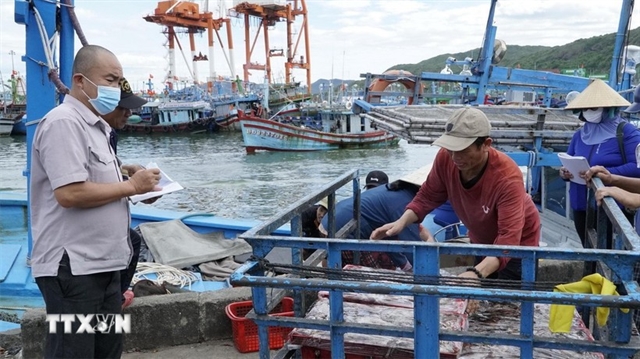 Society
Society
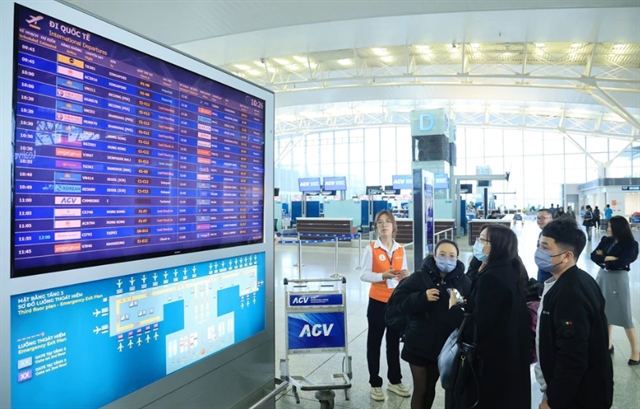
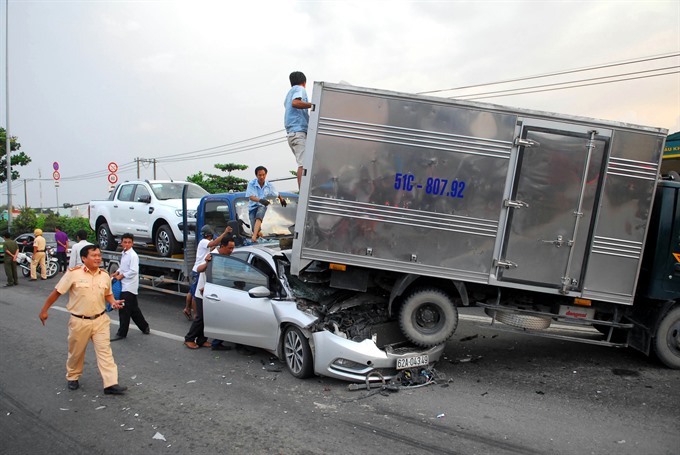 |
| An accident scene in a case where speeding truck collided with three other cars on National Road No.22 (the section passing through Hóc Môn District, HCM City) in August, 2017. All the vehicles sustained serious damages but luckily no one was hurt. — VNA/VNS Photo Mạnh Linh |
“Everyone, I will sell rose bouquets tomorrow in celebration of International Women’s Day. Those who are looking to give flowers to their girlfriends or classmates, please come to support me in front of Gate A of Hải Phòng University.”
So wrote 26-year-old Trần Thị Hoa in one of her last Facebook posts on March 6.
Early on the morning of March 7, Hoa and her friend Trần Thị Trang rode on motorbike to the flower market Đằng Hải in Hải An District in the northeastern port city of Hải Phòng. Not born to wealthy families, the pair intended to buy flowers and utilise their craft skills to make elaborate bouquets, aiming to make some money to cover their study and living expenses.
On that fateful morning, Cao Huy Hoàng was driving a container truck for an export-import company along his usual route. Stopped at a red light, he saw that two trucks ahead of him were already occupying the lane for cars. Hoàng aggressively switched to the lane for motorbikes and bikes to overtake the two trucks — a decision that he did not know he was going to regret for the rest of his life.
Right after he moved into the other lane, he spotted the motorbike carrying the two girls going in the same direction right near the front of his truck. His break was not fast enough. The 40-foot truck crushed the two girls to death.
Photos of the accident site, showing two lifeless bodies covered up on the cold asphalt surface, scattered with piles of crushed rose petals, made their way online and provoked horror and pity from many.
Unfortunately, such a tragic loss of life is not an unusual occurrence in Việt Nam, where traffic road accidents are rampant.
According to the National Traffic Safety Committee, in 2017, the country witnessed a total of 20,000 accidents, claiming the lives of nearly 8,300 people and injuring 17,000 others.
In the last five years, the figure of fatalities has shown a gradual downward trend, but still never dropped below 8,000. Việt Nam’s traffic fatality rate of 24.5 per 100,000 is Southeast Asia’s second-highest, following Thailand, according to the World Health Organisation (WHO). In 2016, the number of deaths even went up by 14 compared to 2015, basically nullifying any perceived improvements in road safety.
“It could be said that while we’re living in peace time, the number of casualties and injured victims from road accidents rivals the carnage of wartime,” exclaimed transport minister Nguyễn Văn Thể earlier this year.
The unfortunate thing is that most accidents are the result of irresponsible behaviour from drivers like Hoàng, who entered traffic with little regard for his own safety, let alone the safety of others. Carelessness creates a fertile ground for accidents, and when they strike, the consequences can be devastating.
VietnamPlus newspaper, under the Vietnam News Agency, has conducted a small study, collating the serious accidents that were reported and caught the public’s attention from 2013 to 2017. There were around 144 cases with at least three casualties (classified as “serious”) across the country. This tentative look at the details of these cases offers important insights into the dismal situation, and might be a starting point for further research as well as the development of viable solutions:
While in general, the number of accidents and the number of deaths are both decreasing, the number of “serious” to “extremely serious” accidents seems to be growing. According to the traffic safety committee, in 2016 there were 62 accidents classified as extremely serious, resulting in a total of 200 deaths. In 2017, the figures rose to 70 cases with 224 deaths.
Similar trends can be observed in the 2013-15 period.
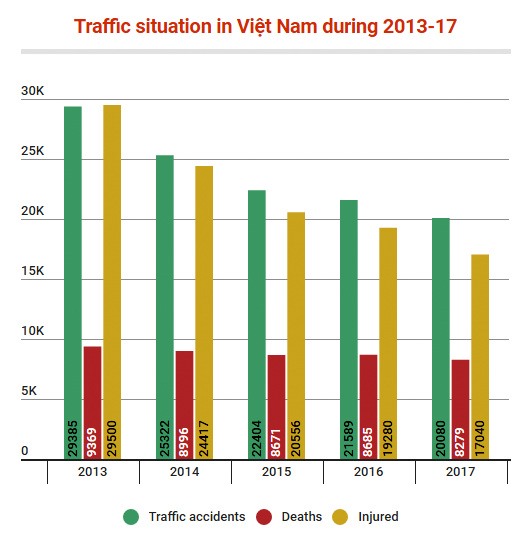 |
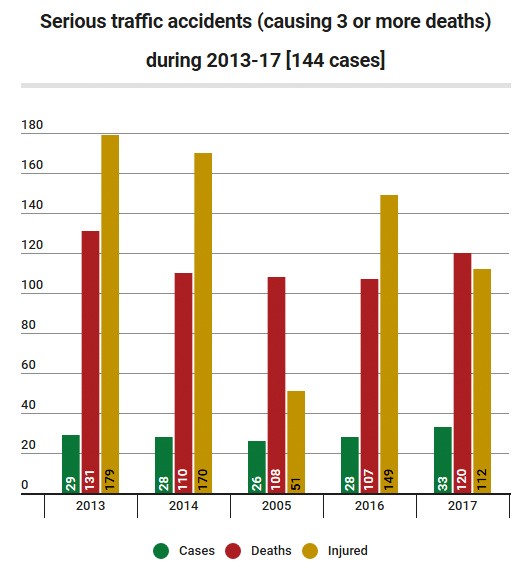 |
There were five provinces/cities that witnessed five serious cases, with Hà Nội topping the list at nine cases. Other than the complicated and busy traffic of the capital city, its top position might have something to do with expanded area since 2008, which now stands at 3,300 sq.km, triple its original area.
Thanh Hoá Province in the central region and Gia Lai Province in the Central Highlands closely followed in second place with nine serious cases each. The central provinces of Nghệ An and Bình Thuận shared third place with 7 cases each.
Statistics revealed that 9pm is actually the most dangerous hour, with 12 devastating accidents taking place around this hour during the five-year period. What’s notable is that this is the time when traffic starts to thin after the occasionally paralysing rush hours. It seems that clearer streets cause drivers to drop their caution. They become prone to speeding and running red lights, behaviour made more dangerous by the darkness and lack of careful road observation. Other dangerous times are 3pm and 4am, also times when traffic is not usually busy.
Meanwhile, February is the month tainted with the most cases of serious accidents as it usually coincides with the time before or after the Tết (Lunar New Year) holiday, when hectic traffic is typical.
December witnesses the least number of serious accidents, with just six cases.
The study noticed that the culprits’ age largely lies in the range of 30-34, causing a total of 28 accidents. Of which, 13 were drivers of trucks, including two container trucks and one heavy rescue vehicle driver, and seven are car drivers.
Only four of the cases are caused by coach drivers, which people refer to as “devils of the highway”. However, due to the massive size of coaches, the accidents’ consequences can be devastating: two coach drivers in this period caused two separate accidents with at least 10 deaths each.
In 2015, driver Nguyễn Thanh Tiến, switched from his lane to the lane designated for motorbikes and crashed head-on into another coach bus going in the opposite direction, causing 10 deaths and nine injuries. The other case involves driver Võ Ngọc Phương, who similarly caused his coach bus to collide with another bus due to over-speeding and travelling in the wrong lane, causing the deaths of 12 passengers and injuring 50 others back in 2013.
Drivers aged 39 and below are responsible for more than 78 per cent of the deadly accidents, while the drivers above 40 years of age caused the rest.
Despite the increasingly popular (though misogynistic) joke in Việt Nam that “selling gas to women is a crime,” men are actually the prime actors in the most serious accidents over the last five years, responsible for 98.61 per cent of the 144 cases. This is not really surprising given that the types of driving jobs that cause serious accidents are male-dominated, especially in Việt Nam where traditional gender roles still exert great influence, and men are pre-disposed to drunkenness and recklessness.
Female drivers only caused two cases out of the 144 studied — a negligible 2 per cent. However, women account for one third of the accidents’ victims, with 178 people.
In the 144 deadliest accidents, cars, trucks or coach buses are each responsible for roughly the same number of accidents, while motorbikes caused 49 accidents. In these accidents caused by motorbike drivers, the drivers themselves are usually amongst the deaths as well.
This should come as no surprise given the ubiquity of motorbikes in Việt Nam, but it indicates room for improvement in the education of drivers operating the country’s most popular vehicle. That said, motorbikes were actually responsible for a small share of serious accidents considering that they comprise over 90 per cent of the country’s registered vehicles. As more Vietnamese purchase cars, traffic safety must be an important component of driver education programmes.
The Vietnamese seem to have an obsession with speeding. In recent times, popular groups for drivers on Facebook have posted lots of videos in which car drivers are travelling much faster than the allowed speed limit as a way of showing off. (The culprits are almost always men.)
Incidentally, speeding is also the leading reason for the most horrific accidents in the last five years, causing a total of 83 cases.
Generally speaking, most causes are considered entirely preventable. Vietnamese drivers and their lax observation of traffic rules are at fault. It’s hard to blame the authorities, or that the fines are not harsh enough, while the chips fall on the shoulders of drivers.
***
Last week, because youth are involved in 40 per cent of the accidents and the children account for a disproportionately high number of deaths, the National Committee for Traffic Safety has chosen the theme for this year as “Traffic safety for children”. They aim to reduce the mortality rate in children by 5-10 per cent and the injury rate by 10 per cent compared to 2017.
Transport minister Nguyễn Văn Thể said education would be the key to solve the currently unsolvable traffic situation:
“When we teach traffic safety to children efficiently, in the future, Việt Nam will have a generation that properly observes traffic safety.”
Thể also pledged to tackle the traffic black spots as well as conduct more road maintenance to reduce accidents.
However, the transport authorities’ best efforts will be for naught if traffic culture remains selfish and unconcerned with safety, especially among the young men whom the data shows are inflicting untold carnage on the country’s roads.
If only each person who goes out into the road actually pays a little more attention to the rules and takes responsibility for their safety and that of others, there will certainly be fewer tragedies than the one that senselessly cut short the lives of Trần Thị Hoa and her friend Trần Thị Trang earlier this year. — VietnamPlus/VNS

.jpg)

